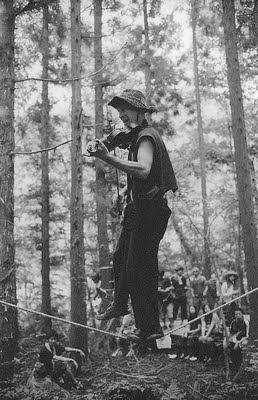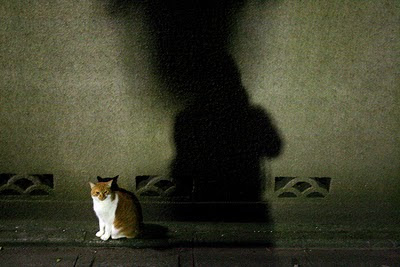三心の構 Sanshin no Kamae: Silent and Deadly
From Bujinkan Santa Monica by Bujinkan Santa Monica
 |
| photo by ngader |
Hatsumi sensei says these Kamae are "three phases:"
型破の構 Kata Yaburi no Kamae – form breaking
無念無想の構 Munen Muso no Kamae – no intention, no thought
音無しの構 Otonashi no Kamae – silent posture
The stances betray no outward signs of readiness for action, offensive or defensive. You stand exposed, weapons lowered, and your body square to the opponent. This emptiness makes these kamae positions of pure, unlimited potential from which all manner of henka can arise. These kamae all pass rapidly from stillness into motion and motion into stillness. Offense and defense are one and the same. Emptiness and reality are embodied in the stances with kyojitsu tenkan ho being a primary strategy.
With 型破の構 Kata Yaburi no Kamae you move in a way to break or destroy the opponent's form. Whether that be the form of his attack or breaking the "form" of his spirit. But this also suggests the destruction of your own form. Or the erasing of your own ego. Which leads us to,
無念無想の構 Munen Muso no Kamae, sometimes referred to as mugamae (non form), is the intention of no-intention, no-thought throughout your body or any weapon you hold.
So with 音無しの構 Otonashi no Kamae, you are lying low; saying nothing and waiting for an opportunity. It is critical to use space, without showing your weapon, the form, the shape, or the sound. Use it in the unguarded space to take away the opponent's fighting power.
Soke describes this,
"you stand silently in otonashi no kamae (the silent posture) with both hands lowered. Even against a strong opponent you maintain this form. The cross style of this form has a secret meaning that includes both desperation and sacrifice."
The power of this stance often appears in cinema and theater. Sawada Shojiro returned to Tokyo with Daibosatsu Toge, 1921-1922). In this performance Sawada played Tsukue Ryunosuke, a ruthless and nihilistic swordsman who goes blind but his swordsmanship does not diminish. Ryunosuke's "soundless stance" (otonashi-no-kamae) sword-fighting style inspired many chanbara heroes that followed including the blind swordsman Zato Ichi.
The role of Ryunosuke Tsukue was reprised in the movie "Sword of Doom" by Tatsuya Nakadai in 1966. In this clip we can see Otonashi no kamae at work (WARNING graphic sword fight):









